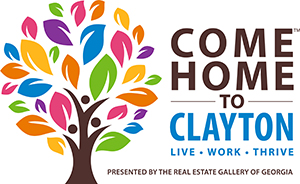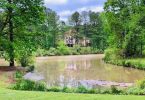Clayton County’s efforts to create a community that promotes walking and other physical activities provide benefits for Clayton County.
Riverdale, Rex, Forest Park, Lovejoy, Morrow, College Park, and Jonesboro have made some improvements in adding sidewalks in business districts and residential areas. In fact, downtown Jonesboro is becoming a “walkability” template.
Meanwhile, a major player in creating walkable communities throughout metro Atlanta is making a big splash in Clayton with its Clayton Connects project.
So what exactly does walkability mean? It means linking communities in compact neighborhoods so residents can walk to nearby stores, cafés, workplaces, and entertainment venues while encountering neighbors in an atmosphere of vibrant community cohesion.
For example, downtown Jonesboro is loaded with atmosphere and charm. The brick-lined sidewalk of S. Main Street is just made for strolling. A café, souvenir shop, business offices, and the Arts Clayton Gallery are neatly aligned on a single block adjacent to the grounds of the old Clayton County Courthouse. With the area’s historic homes, churches, banks, amphitheater and residential areas within easy walking distance, Jonesboro has the makings of a downtown walkability showcase.
City officials in Jonesboro are taking action. The Downtown Development Authority of the City of Jonesboro is attracting new development, and the city has created a designated Downtown Entertainment District zoning area.
At the same time, the nonprofit PATH Foundation, a longtime creator and influencer of walkable communities in metro Atlanta, is making a big splash in Clayton with its Clayton Connects project.
PATH started its walkability plan in Clayton in 2016 by creating walking and biking trails to promote physical activity in the county. To date, Clayton Connects has opened six miles of greenway trails, connecting International Park and the Lake Spivey Golf Club to Crane Road. Within this area, the trail also links Atlanta Beach, J. Charley Griswell Senior Center and several Lake Spivey neighborhoods.
Much more is on the way.
An astonishing 120 miles of greenways will ultimately link downtown Jonesboro, Clayton State University, Riverdale, Rex, and College Park near Hartsfield- Jackson International Airport.
PATH also has helped preserve metro Atlanta’s forested character by building more than 30 scenic greenways totaling more than 260 miles since 1991, attracting walkers and bicyclists by the tens of thousands every year.
With its fundraising prowess, the ability to obtain matching funds, and supported by SPLOST, PATH is changing the face of Clayton County through Clayton Connects.
Connecting our communities with walking and biking paths will be a tremendous boost to walkability and a Clayton County game changer. With the recent announcement of Marta adding a commuter rail line for Clayton, the county will be poised to connect residential areas and business districts with walking trails and transit options to anywhere and everywhere.
Here are ways planning and development officials across the country are pursuing the benefits of creating more walkable communities:
Increasing Real Estate Values and Taxes
WalkScore.com places a numerical value on the walkability of addresses around the country. Their data show that for each walkability point, home value increases by $500 to $3,000.
A recent Washington Post article predicts walkable neighborhoods will increase as millennials move into the housing market.
Promoting Public Safety
With more people walking the neighborhood, awareness grows, and violators become less likely to commit crimes.
Stimulating Neighborhood Revitalization and Economic Development
Consumers who visit multiple shops clustered in a compact area and make several individual purchases rather than one large one increases their overall spending. Tourism tends to rise in walkable communities, expanding small business opportunities. Home buyers are more frequently asking for homes in walkable neighborhoods.
Encouraging Health and Well Being
The PATH Foundation points out that whether trail users are walking, riding, skating or rollerblading, they are on their way to better health. Just as important, they are seeking opportunities to live a healthier lifestyle; walkable communities attract health-conscious people.
Improving the Environment
The Washington Post reports that walkable communities encourage fewer car trips since residents can walk to almost everything they need, improving air quality and reducing the mental and physical toll of too much time behind the wheel.
The bottom line is this: Walkability adds cohesion and vibrancy to communities – creating a livable sense of place home buyers are desiring. Clayton County and Clayton County Real Estate is taking this trend in the right direction.

Brick-lined sidewalks in downtown Forest Park, GA are apart of its Main Street Redevelopment project.
#comehome2clayton
______________________________________
Also Read:
Search Clayton County Real Estate for Sale
Millennial homebuyer taking the helm of homeownership
Jonesboro to bring arts and entertainment district to Clayton








Great story!
[…] Clayton County Making Strides in Walkable Communities […]
[…] wonderful neighborhood amenities including the Lake Spivey Golf Club and restaurant, swimming pool, walking trails; and The Atlanta Beach […]
[…] Clayton Connects is opening mile after mile of a master-planned 112-mile walking and biking trail system connecting Clayton communities and Atlanta-area trails. […]
[…] Clayton County Making Strides in Walkable Communities […]